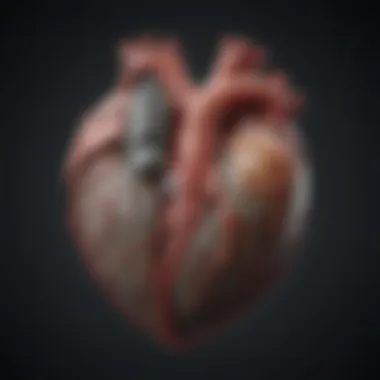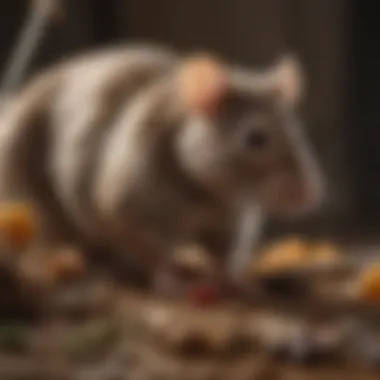Understanding Heart Traps for Effective Rat Control


Intro
The management of rat populations within residential areas has become a pressing concern for many homeowners. As urban environments continue to expand, the chances of rodent infestations rise. Understanding the efficacy of heart traps in this context is crucial. Heart traps are designed to effectively capture rats while minimizing suffering, contrasting sharply with traditional methods that can be more harmful.
In this article, we will examine the foundational aspects of heart traps, exploring their mechanics, benefits, and practical applications. The implications of these traps within residential settings will also be discussed, making it essential for readers—including homeowners, renters, and pest control professionals—to grasp the principles at play. This knowledge not only empowers them, but also aids in the decision-making process regarding rodent management strategies.
Pest Identification
Before addressing the utility of heart traps, identifying the pests themselves is important. Rats can broadly be categorized into two types: the Norway rat and the roof rat.
Detailed descriptions of common pests
- Norway Rat: This species is heavier with a more robust build. Its fur is coarse and typically brown, with a lighter underside. Norway rats prefer to dwell in burrows and are often found near the ground.
- Roof Rat: Smaller and slimmer than the Norway rat, roof rats are agile climbers. Their fur is smoother and generally black or dark brown. They tend to nest high, such as in trees, attics, or other elevated spaces.
Signs and symptoms of infestations
Identifying an infestation promptly can mitigate extensive damage:
- Droppings: Fresh droppings signal recent activity. Norway rats produce larger droppings than roof rats.
- Gnaw marks: Look for bite marks on wood, wires, or food packages.
- Noise: Scratching or scurrying sounds, especially at night, indicate rat movement.
- Tracks: Footprints and tail marks may be visible in dust or dirt.
By understanding these signs, homeowners can act earlier to prevent escalation. Identifying the type of rat present can influence the choice of control methods, including the appropriate use of heart traps.
Prevention Strategies
Effective management starts with prevention. Taking proactive measures can significantly reduce the chances of rat infestations.
Home maintenance tips for pest prevention
- Seal Entry Points: Inspect the home for gaps, holes, or cracks. These should be sealed to deny rats entry.
- Proper Storage: Store food in airtight containers. Ensure pet food is not left outside overnight.
- Maintain Cleanliness: Regularly clean up spills and crumbs that might attract rats.
Natural deterrents and barriers
Several natural options can act as barriers or deterrents:
- Peppermint Oil: The scent of peppermint can repel rats. Using oil in cotton balls placed around entry points can discourage them.
- Ultrasonic Repellents: These devices emit sound frequencies that are unpleasant for rodents but inaudible to humans.
Incorporating these practices can create an environment less welcoming to rats.
Treatment Options
Understanding your treatment options is crucial once an infestation is confirmed. Heart traps present a humane alternative to more traditional methods.
Overview of chemical vs. natural treatments
- Chemical Treatments: These include poison baits. While effective, they pose risks to other wildlife and pets.
- Natural Treatments: Utilizing traps, especially heart traps, offers a non-toxic approach and significantly reduces harm to the surrounding environment.
Step-by-step guides for DIY treatments
- Identify: Confirm the presence of a rat infestation using signs outlined above.
- Select Heart Traps: Choose high-quality heart traps known for reliability. Brands such as Victor or Kat Sense are popular choices.
- Placement: Situate traps in areas where rat activity is noticed. Ensure they are away from pets and children.
- Bait: Use attractive bait like peanut butter or dried fruit to lure rats in.
- Check Regularly: Monitor traps daily to ensure swift action.
By following these steps, homeowners can effectively manage rat populations, leveraging the humane nature of heart traps while aligning with ethical pest control standards.
Foreword to Heart Traps
The management of rat populations remains a significant concern for many homeowners. The persistent presence of rodents can lead to property damage, contamination of food supplies, and the spread of diseases. In this context, heart traps have emerged as a viable tool in rat management. This section aims to illuminate the importance of heart traps, detailing their roles, functionalities, and the benefits they bring to pest control.
Definition and Purpose


Heart traps are specialized devices designed to capture rats, mitigating their negative impact on homes and surrounding environments. Unlike traditional traps, heart traps focus on both effectiveness and humane capture. The core purpose is to provide homeowners with a reliable method to manage rat populations safely and efficiently. They are often favored due to their user-friendly design and higher rate of effectiveness compared to other trapping methods.
The design of heart traps allows for easy setup in various environments, making them suitable for both indoor and outdoor use. Their operation hinges on attracting rats, leading them to a contained space where they are safely captured without causing injury. This humane approach appeals to many who prioritize the ethical dimensions of pest control while seeking to maintain the integrity of their homes.
History of Rat Control Methods
Historically, the methods of controlling rat populations evolved significantly from simple traps to more advanced systems. Early techniques included the use of manual traps, poisons, and even natural predators. These methods, while occasionally effective, often posed risks to non-target wildlife and raised ethical concerns regarding animal welfare.
The shift towards more sophisticated pest management began in the mid-20th century with the introduction of snap traps and rodenticides. However, these methods frequently resulted in unintended injuries to pets and the environment. The development of heart traps aligns with a growing awareness of humane pest control, providing a more ethical alternative without compromising efficacy.
Through this understanding of the historical context, we can appreciate the evolution of rat management strategies. Heart traps represent not just innovation but a convergence of effectiveness and ethical responsibility. This makes them particularly relevant in contemporary discussions on pest control.
Mechanics of Heart Traps
Understanding the mechanics of heart traps is crucial for effectively managing rat populations. This section highlights the essential design features and operating principles that contribute to their function. By comprehending how heart traps work, homeowners can make informed decisions about their pest management strategies.
Design Features
Materials Used
The materials used in the construction of heart traps play a significant role in their durability and functionality. Metal and high-grade plastic are common, providing strength and longevity. Metal traps are typically resilient against wear and tear, making them a popular choice. On the other hand, plastic traps can be lightweight and easy to handle. The main advantage of these materials is that they can withstand outdoor conditions, ensuring the traps remain effective over time.
The unique feature of metal traps is their sturdiness, which can help in preventing damage from aggressive rodents. While plastic traps may be less durable, they often appeal to those looking for more affordable options. A careful consideration of these materials enriches the discussion surrounding heart traps and their effectiveness in controlling rat populations.
Size and Capacity
The size and capacity of heart traps are integral to their success in capturing rats. Most traps are designed to be compact yet spacious enough to accommodate multiple rodents. A key characteristic of these traps is their ability to minimize false triggers, which can occur with larger traps. This efficiency is essential for anyone managing rodent issues in residential settings.
The advantage of appropriately sized traps is their unobtrusiveness, allowing for placement in narrow spaces. Large traps may be more visible or cumbersome, deterring some homeowners from using them. Proper sizing can maximize capture rates and reduce the chances of escape.
Trigger Mechanisms
Trigger mechanisms are pivotal to the operation of heart traps. These traps utilize sensitive mechanisms that activate when a rodent enters the trap. This sensitivity is advantageous as it enhances the likelihood of successful captures. Many traps feature paddle or lever systems that respond instantly, ensuring that the trap is effective even with minimal movement.
The unique aspect of these trigger mechanisms lies in their accuracy. Unlike some traditional traps that can malfunction, heart traps are designed to minimize these issues. Properly functioning triggers can lead to higher capture rates and reduce the need for frequent repositioning, making heart traps reliable for pest control.
How Heart Traps Operate
Principle of Attraction
The principle of attraction involves using bait or design features that lure rodents into the trap. Commonly, food items like peanut butter or grains serve this purpose. This principle allows homeowners to target specific areas where rodent activity is prevalent. By understanding rodent behavior, individuals can increase the chances of successful captures.
A key characteristic of this principle is its efficiency. By using appropriate bait, homeowners can significantly increase the odds of encountering rats. This tailored approach highlights the effectiveness of heart traps in various settings.
Triggering the Trap
Triggering the trap is a crucial step that ensures effective capture. As soon as a rodent interacts with the bait or moves within the trap, the mechanism is activated. This straightforward operational aspect makes heart traps user-friendly and practical for many homeowners facing rodent challenges.
The main advantage of responsive triggering is that it reduces the need for continuous monitoring. Once correctly positioned, the trap will capture without extensive oversight. This simplicity appeals to those seeking effective pest management solutions without exorbitant effort.
Capturing Mechanism
The capturing mechanism refers to how the trap secures the rodent once triggered. Many heart traps utilize a design that confines the rodent without causing injury. This characteristic is essential for homeowners who wish to practice humane pest control.
The innovation in capturing mechanisms stands out because it not only ensures effectiveness but also takes ethical considerations into account. Avoiding injury or death can enhance the perception of pest control measures as responsible and considerate. This aspect of heart traps fits well into broader discussions on humane treatment of pests.
Comparative Analysis of Rodent Control Methods


The comparative analysis of rodent control methods is essential for understanding the effectiveness of heart traps in managing rat populations. By placing heart traps next to traditional methods like snap traps and poison baits, we can assess their pros and cons. This analysis helps homeowners make informed choices regarding pest control strategies that align with their values and circumstances. The systematic examination also sheds light on safety and environmental considerations, making it a vital component of this article.
Heart Traps vs. Traditional Snap Traps
Effectiveness and Efficiency
Effectiveness and efficiency are critical factors when choosing a rodent control method. Heart traps have shown high efficacy in capturing rats due to their design features. This characteristic contributes significantly to their popularity among pest control professionals. Unlike traditional snap traps that rely on mechanical force, heart traps utilize a different mechanism to attract and capture rats. The unique feature of heart traps lies in their ability to catch multiple rodents at once, which can be an advantage in high-infestation areas.
Safety Considerations
Safety considerations are fundamental in rodent control discussions. Heart traps present a safer alternative compared to traditional methods. They minimize risks to pets and children, a concern shared by many homeowners. This aspect makes heart traps a beneficial choice for families who prioritize safety in pest management. The design of heart traps usually prevents accidental triggering, which is a common issue with snap traps. Thus, their relative safety is a notable advantage in this context.
Cost Assessment
Cost assessment plays an crucial role in deciding on pest control methods. Heart traps tend to have a higher initial purchase price compared to traditional snap traps. However, over time, they can be more cost-effective due to their durability and reusability. This unique feature means fewer replacements are needed, which contributes to their overall value. While upfront costs are higher, their long-term investment potential is beneficial for homeowners looking for sustainable solutions.
Heart Traps vs. Poison Baits
Health Risks to Pets and Wildlife
Health risks to pets and wildlife are significant concerns when considering rodent control strategies. Poison baits, while effective, pose a considerable risk to non-target animals. Heart traps, on the other hand, primarily target rats, minimizing unintentional harm to other animals. This characteristic is compelling for those who have pets or live in areas where wildlife is present. The reduced health risks associated with heart traps make them an appealing option for conscientious homeowners.
Environmental Impact
The environmental impact of pest control methods is another crucial factor to evaluate. Poison baits can introduce harmful chemicals into local ecosystems, with consequences for both wildlife and water sources. In contrast, heart traps do not release toxins into the environment. This unique feature makes them a more ecologically responsible choice, especially for those concerned about sustainability. By opting for heart traps, homeowners may better align their pest control practices with environmental preservation goals.
Long-Term Efficacy
Long-term efficacy is an important consideration in any rodent control strategy. Heart traps have demonstrated their ability to capture multiple rodents over time, maintaining their effectiveness in ongoing infestations. Although poison baits can be effective in the short term, their efficacy may diminish if rodents develop bait aversion. The unique attribute of heart traps ensures ongoing effectiveness, which is vital for maintaining control over rat populations in the long term.
Key Takeaway: The comparative analysis of heart traps reveals essential insights about their effectiveness, safety, cost, and environmental impact, making them a compelling choice for rat management.
By carefully evaluating each method's strengths and weaknesses, homeowners can make informed decisions that best suit their individual needs and ethical considerations.
Best Practices for Utilizing Heart Traps
Using heart traps effectively requires more than simply setting them in place. Best practices are crucial for achieving optimal results and ensuring humane treatment of captured rats. Proper implementation can significantly enhance the effectiveness of heart traps compared to other methods. This section guides readers through the key elements that enhance the successful use of heart traps. Whether you are a homeowner dealing with a rat problem or a pest control professional, understanding these best practices is important.
Placement Strategies
Identifying Rodent Trails
Identifying rodent trails is a key element in rat management. By observing signs of rat activity like droppings, gnaw marks, or burrows, homeowners can strategically place heart traps where they will be most effective. A distinctive feature of this practice is its reliance on rats’ natural behavior; they tend to follow established paths. This approach is popular because it increases the likelihood of capturing rats quickly. However, it requires a careful examination of the property, which some may find time-consuming.
Optimal Locations
Choosing optimal locations for traps can significantly affect the success rate of capturing rats. Areas near food sources, nesting sites, and sheltered spaces are often ideal. A key characteristic of this strategy is that it considers the rats' habits and preferences for safety and food. Optimal locations increase the chances of contacting rats when they are most active. One drawback is that if the chosen sites are not frequently inspected, the traps may go unnoticed and lose effectiveness.
Avoiding Human Interference
Avoiding human interference is vital for the successful operation of heart traps. This means placing traps in areas that are not prone to human traffic. A notable aspect is that avoiding disturbances not only aids in trapping but also ensures safety for pets and children. This practice is beneficial since it minimizes the risk of unintended encounters with the traps. However, careful planning is needed to ensure that the traps remain accessible for maintenance and monitoring purposes.
Maintenance and Monitoring
Regular Checks
Regular checks of heart traps are imperative to maintain their effectiveness. Frequent monitoring helps to ensure that captured rats are removed promptly, minimizing stress for the animals and maintaining hygiene in the area. A key characteristic is that it allows the user to assess whether traps are functioning properly. This practice is beneficial as it ensures that operations continue smoothly. However, it may require a commitment of time and consistency that some users might overlook.


Cleaning Procedures
Cleaning procedures for heart traps is critical to overall hygiene and effectiveness. It ensures that traps are free from debris and residual scents that may deter rats from approaching. An important feature of this practice is that it prevents the spread of disease. Regular cleaning is a preferred choice, enhancing the success of trapping efforts while remaining ethical. Nevertheless, users must handle cleaning materials safely to avoid any harmful reactions or effects.
Trap Resetting Techniques
Mastering trap resetting techniques is essential after a capture. This allows for immediate reuse of the traps without delay. A distinct characteristic of this practice is its simplicity; many traps are designed for quick resetting. Efficient resetting is beneficial because it maximizes the potential for additional captures. However, users must be cautious during the resetting process to avoid accidental injuries.
Ethical Considerations in Pest Control
In the context of rodent management, ethical considerations play a crucial role. This section discusses the humane treatment of rats and broader implications associated with pest control. As society becomes more aware of animal welfare, understanding how to effectively and ethically manage rat populations is imperative. This approach leads to a more comprehensive view of pest control, which not only addresses immediate concerns but also respects the ecological balance.
Humane Treatment of Rats
Understanding Rat Behavior
Understanding rat behavior is essential for effective pest management. Rats are social creatures with complex behaviors and create hierarchies within their communities. By recognizing patterns of movement and nesting, homeowners can better target their traps.
This knowledge about behavior also aids in reducing unnecessary captures. For instance, placing traps in paths commonly used by rats increases the chances of successful trapping, while also minimizing stress to the animals.
Stress Minimization Techniques
Minimizing stress for captured rats is not only humane but can also improve efficacy in pest control. Using techniques such as soft cloths placed over traps can help calm the animals. This practice reduces frantic movements, which could lead to injuries.
Such measures have drawn attention from pest control professionals aiming for humane solutions. They highlight that stress reduction methods can contribute to a more ethical approach. However, these techniques may require more time and resources, which can be viewed as a disadvantage by some owners seeking quick solutions.
Post-Capture Handling
Post-capture handling addresses the steps taken after a rat has been trapped. Careful handling is vital to ensure the rat's welfare. This may involve relocating the rat to a less populated area or humane euthanasia when necessary. Educating homeowners on proper techniques is beneficial.
Moreover, these practices enhance the image of pest control professionals who prioritize humane methods. Nonetheless, there may be disagreements about what constitutes ethical handling, leading to variances in practices across different regions.
Broader Implications for Pest Management
Impact on Ecosystems
The impact of rodent control on ecosystems is a significant consideration. Rats play a role in their environments that can be both beneficial and detrimental. They contribute to prey populations while also being carriers of diseases. Understanding this balance is crucial when deciding on control measures.
Ethical pest management practices that consider ecosystem integrity can lead to more sustainable outcomes. However, tackling rat infestations may sometimes require strong measures that can disrupt local wildlife, presenting a challenge for pest control.
Regulatory Considerations
Regulatory aspects of pest management are ever-evolving. Laws surrounding the treatment of animals, including humane guidelines for dealing with pests, are critical in shaping effective management strategies. Compliance with regulations ensures that pest control methods do not harm other wildlife or violate educational and ethical standards.
If practitioners ignore regulations, they risk fines and reputational damage. Thus, being aware of the latest rules is essential for both homeowners and pest control professionals.
Public Perception of Pest Control
Public perception significantly influences pest control practices. As people grow more environmentally conscious, there is an increasing demand for humane pest control options. This trend has led to the rise of companies specializing in eco-friendly and humane methods. Understanding public sentiment is important for industry practitioners.
Educating the public on the importance of humane methods may help mitigate resistance to necessary control measures. However, traditional perceptions of pest control can sometimes conflict with current ethical practices, making this a pertinent issue for professionals in the field.
Closure
Summary of Key Points
- Definition and Purpose: Heart traps effectively capture rats without killing them, reflecting a humane approach.
- Mechanics of Heart Traps: The design, including materials, size, and triggering mechanisms, plays a crucial role in their functionality.
- Comparative Analysis: When comparing heart traps to traditional snap traps and poison baits, heart traps offer unique advantages in terms of safety for pets and the environment.
- Best Practices: Proper placement and maintenance maximize their effectiveness. Identifying rodent trails and checking traps regularly are key strategies.
- Ethical Considerations: The humane treatment of rats and the potential impact on ecosystems underscore the importance of ethical pest management.
Future Trends in Rodent Control
As the landscape of pest control evolves, several trends emerge regarding rodent management:
- Technological Innovations: Advances in trap design and functionality are likely to improve efficacy. Smart traps that alert users upon capturing a rat may become more widespread.
- Sustainable Practices: An increasing emphasis on environmentally friendly pest control will promote the use of heart traps. Households will prefer methods that align with eco-conscious values.
- Educational Initiatives: Future efforts will focus on educating homeowners about humane pest control methods. Awareness of humane options will influence consumer choices.
- Legislative Changes: Potential regulations may arise, emphasizing humane treatment of pests. This evolution could shape pest control practices on a broader scale.
In summary, the conclusion of this discourse not only reinforces the significant role of heart traps in rodent control but also looks ahead to future developments that will inspire innovative, ethical approaches to pest management.



